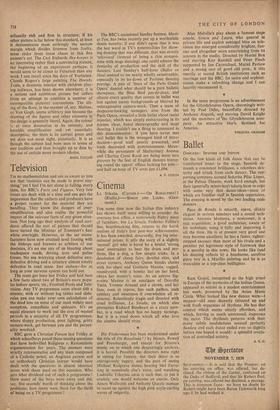Painting
THE LONDON GROUP
BECAUSE the London Group- exhibition, which is being held in the Whitechapel Art Gallery is, this year, confined to members, there is an opportunity to identify what the Group seals to stand for in 1955 and consider what its most useful function can be after a life of forty-on‘ years. It is the latest significant association of artists to survive so long—the Seven and Five' Unit One, the Euston Road Group are among the obvious casualties from the Twenties and Thirties—and it is difficult not to believe that the age of such societies is past, unless they happen to be directed by a most dogmatic and limited orthodoxy. The exhibition under review hardly reflects the current debates over 'new realism' or non-figurative art; Victor Pasmore and Robert Adams, for example, are not showing, and the Beaux Arts painters an not belong. The predominant flavour, in fact, is what it was in 1914, post-Impressionism and the School of Paris, Cdzanne, Van Gogh, the Fauves, Cubism, in an English translation. Tin work of such different painters as Claude: Rogers and Ceri Richards, lvon Hitchens and William Townsend, Matthew Smith and Patrick Heron, Robert Medley and Mary Potter, could all be related to Roger RY.s central principles, if not to the details of '11',5 taste and appreciation. These are the artists in fact, with Josef Herman and Anthony RY' represented by an excellent landscape, whose work gives the Group and the show coherence and vitality. But these and other artists oath similar intentions seem to be subscribers to, `1 group rather than to be members of it in on literal sense of the word. Nor do any of then require its assistance. Perhaps the main fuse.. tion of such associations these days—and thus would apply equally to the New English A!'t Club and the Academy—is to provide an exiir bition place for 'those artists who have yet to secure the recognition of a one-man shoW. Together with Matthew Smith's Coral Necklace of 1926, Hitchcns's smaller picture; Red Landscape, is the best painting here, mot abstract than some of his landscapes, Inag, nificently rich and firm in structure; if his other picture is far below this standard, at least it demonstrates most strikingly the narrow margin which divides firmness from frailty, tense order from loose chaos in this fine painter's art. The Ceri Richards Bee-keeper is an interesting rather than a convincing picture, the beginning of an experiment perhaps; it would seem to be closer to Futurism than any work I can recall since the days of Vorticism. Claude Rogers's large painting The Horn by Train, a domestic interior with children play- ing railways, has been shown elsewhere; it is a serious and ambitious picture but suffers from an attempt to combine a number of incompatible pictorial conventions. The tilt- ing of the floor, in the manner of, say, Matisse, or Van Gogh, seems arbitrary just because the drawing of the figures and other elements in the design is generally literal. Again, the colour is at once decorative in its intensity and heraldic simplification and yet essentially descriptive; the train is its correct green and yet does not seem right, pictorially. It is as though the subject had been seen in terms of one tradition and then brought up to date by the use of certain more modern idioms.
BASIL TAYLOR



























































 Previous page
Previous page